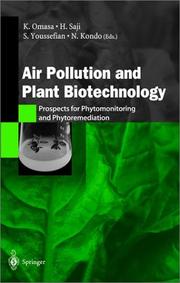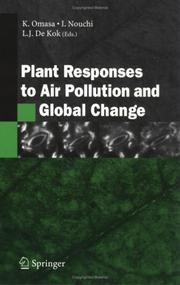| Listing 1 - 9 of 9 |
Sort by
|
Book
ISBN: 4431701761 4431669019 4431668993 Year: 1996 Publisher: Springer Japan
Abstract | Keywords | Export | Availability | Bookmark
 Loading...
Loading...Choose an application
- Reference Manager
- EndNote
- RefWorks (Direct export to RefWorks)
ECO Ecology --- climate maps --- climatic changes --- climatic gradient --- climatology --- ecology --- global warming --- modelling --- mountain vegetation --- phenology --- site dynamics --- subalpine forest
Article
Abstract | Keywords | Export | Availability | Bookmark
 Loading...
Loading...Choose an application
- Reference Manager
- EndNote
- RefWorks (Direct export to RefWorks)
Digital
ISBN: 9784431310143 Year: 2005 Publisher: Tokyo Springer-Verlag Tokyo
Abstract | Keywords | Export | Availability | Bookmark
 Loading...
Loading...Choose an application
- Reference Manager
- EndNote
- RefWorks (Direct export to RefWorks)

ISBN: 4431702164 9784431702160 Year: 2002 Publisher: Tokyo Springer
Abstract | Keywords | Export | Availability | Bookmark
 Loading...
Loading...Choose an application
- Reference Manager
- EndNote
- RefWorks (Direct export to RefWorks)
Plants --- Plant indicators --- Air --- Phytoremediation --- Effect of air pollution on --- Pollution --- Measurement

ISBN: 1280803843 9786610803842 4431310142 4431310134 4431546421 Year: 2005 Publisher: Tokyo : Springer,
Abstract | Keywords | Export | Availability | Bookmark
 Loading...
Loading...Choose an application
- Reference Manager
- EndNote
- RefWorks (Direct export to RefWorks)
The main force behind climate change is the elevated concentration of CO2 in the at mosphere. Carbon dioxide and air pollutants come mostly from the same industrial sources and diffuse globally, so that air pollution is also part of global change in the pre sent era. The impacts on plants and plant ecosystems have complex interrelationships and lead to global change in a circular manner as changes in land cover and atmospheric and soil environments. Plant metabolism of CO2 and air pollutants and their gas fluxes in plant ecosystems influence the global gaseous cycles as well as the impacts on plants. The 6th International Symposium on Plant Responses to Air Pollution and Global Changes was held at the Tsukuba Center for Institutes and Epochal Tsukuba, in Tsukuba, Japan, October 19-22, 2004. The aim of the symposium series is to bring together scien tists of various disciplines who are actively involved in research on responses of plant metabolism to air pollution and global change. The previous symposia were held in Ox ford, UK, 1982 (1st), in Munich, Germany, 1987 (2nd), in Blacksburg, USA, 1992 (3rd), in Egmond aan Zee, The Netherlands, 1997 (4th), and in Pulawy, Poland, 2001 (5th).
Plants --- Trees --- Climatic changes. --- Global environmental change. --- Effect of air pollution on. --- Plants, Effect of air pollution on --- Air --- Environmental change, Global --- Global change, Environmental --- Global environmental changes --- Change --- Ecology --- Changes, Climatic --- Climate change --- Climate changes --- Climate variations --- Climatic change --- Climatic changes --- Climatic fluctuations --- Climatic variations --- Global climate changes --- Global climatic changes --- Climatology --- Climate change mitigation --- Teleconnections (Climatology) --- Dendrology --- Nursery stock --- Woody plants --- Arboriculture --- Forests and forestry --- Timber --- Pollution --- Physiological effect --- Effect of pollution on --- Environmental aspects --- Changes in climate --- Climate change science --- Botany. --- Pollution. --- Biotechnology. --- Environmental protection. --- Endangered ecosystems. --- Plant Sciences. --- Pollution, general. --- Atmospheric Protection/Air Quality Control/Air Pollution. --- Climate Change. --- Ecosystems. --- Threatened ecosystems --- Biotic communities --- Nature conservation --- Environmental quality management --- Protection of environment --- Environmental sciences --- Applied ecology --- Environmental engineering --- Environmental policy --- Environmental quality --- Chemical engineering --- Genetic engineering --- Chemical pollution --- Chemicals --- Contamination of environment --- Environmental pollution --- Contamination (Technology) --- Asbestos abatement --- Bioremediation --- Factory and trade waste --- Hazardous waste site remediation --- Hazardous wastes --- In situ remediation --- Lead abatement --- Pollutants --- Refuse and refuse disposal --- Botanical science --- Phytobiology --- Phytography --- Phytology --- Plant biology --- Plant science --- Biology --- Natural history --- Plant science. --- Air pollution. --- Climate change. --- Biocenoses --- Biocoenoses --- Biogeoecology --- Biological communities --- Biomes --- Biotic community ecology --- Communities, Biotic --- Community ecology, Biotic --- Ecological communities --- Ecosystems --- Natural communities --- Population biology --- Air contaminants --- Air pollutants --- Air pollution --- Air pollution control --- Air toxics --- Airborne pollutants --- Atmosphere --- Contaminants, Air --- Control of air pollution --- Pollutants, Air --- Toxics, Air --- Air quality --- Atmospheric deposition --- Control --- Floristic botany --- Global environmental change
Article
Abstract | Keywords | Export | Availability | Bookmark
 Loading...
Loading...Choose an application
- Reference Manager
- EndNote
- RefWorks (Direct export to RefWorks)
Article
Abstract | Keywords | Export | Availability | Bookmark
 Loading...
Loading...Choose an application
- Reference Manager
- EndNote
- RefWorks (Direct export to RefWorks)
Book
ISBN: 9784431310143 Year: 2005 Publisher: Tokyo Springer-Verlag Tokyo
Abstract | Keywords | Export | Availability | Bookmark
 Loading...
Loading...Choose an application
- Reference Manager
- EndNote
- RefWorks (Direct export to RefWorks)
The main force behind climate change is the elevated concentration of CO2 in the at mosphere. Carbon dioxide and air pollutants come mostly from the same industrial sources and diffuse globally, so that air pollution is also part of global change in the pre sent era. The impacts on plants and plant ecosystems have complex interrelationships and lead to global change in a circular manner as changes in land cover and atmospheric and soil environments. Plant metabolism of CO2 and air pollutants and their gas fluxes in plant ecosystems influence the global gaseous cycles as well as the impacts on plants. The 6th International Symposium on Plant Responses to Air Pollution and Global Changes was held at the Tsukuba Center for Institutes and Epochal Tsukuba, in Tsukuba, Japan, October 19-22, 2004. The aim of the symposium series is to bring together scien tists of various disciplines who are actively involved in research on responses of plant metabolism to air pollution and global change. The previous symposia were held in Ox ford, UK, 1982 (1st), in Munich, Germany, 1987 (2nd), in Blacksburg, USA, 1992 (3rd), in Egmond aan Zee, The Netherlands, 1997 (4th), and in Pulawy, Poland, 2001 (5th).
Book

ISBN: 3110278960 3110381427 9783110278965 9783110381429 9783110278866 3110278863 9783110278972 3110278979 Year: 2014 Publisher: Berlin Boston
Abstract | Keywords | Export | Availability | Bookmark
 Loading...
Loading...Choose an application
- Reference Manager
- EndNote
- RefWorks (Direct export to RefWorks)
This book introduces fundamental principles and practical application of techniques used in the scalable production of biopharmaceuticals with animal cell cultures. A broad spectrum of subjects relevant to biologics production and manufacturing are reviewed, including the generation of robust cell lines, a survey of functional genomics for a better understanding of cell lines and processes, as well as advances in regulatory compliant upstream and downstream development. The book is an essential reference for all those interested in translational animal cell-based pharmaceutical biotechnology.
Animal cell biotechnology. --- Pharmaceutical biotechnology. --- Biopharmaceutical technology --- Drugs --- Biotechnology --- Pharmaceutical technology --- Animal cells in biotechnology --- Animal biotechnology --- Biologics Manufacturing. --- Biopharmaceutical Engineering. --- Biotechnology. --- Cell Culture Engineering. --- Virus Production.
| Listing 1 - 9 of 9 |
Sort by
|

 Search
Search Feedback
Feedback About UniCat
About UniCat  Help
Help News
News